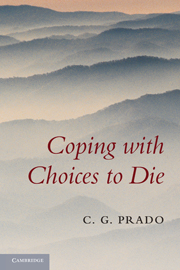4 - Revising the Criterion for Rational Elective Death
Published online by Cambridge University Press: 05 June 2012
Summary
The criteria I developed to establish that elective death – suicide, assisted suicide, and requested euthanasia – can be rational have gone through a number of revisions. The first revision was a result of my realization that the criteria were too detailed and extensive to be of practical use. I learned this from objections raised at conferences, from constructive criticism by colleagues and reviewers, but especially from what I can only describe as impatient dismissal of the criteria by the medical practitioners with whom I discussed them. It became clear that the criteria had to be considerably more practical and brief. What also emerged was that since I first formulated the criteria for the first edition of The Last Choice: Preemptive Suicide in Advanced Age, a new element entered into the elective-death issue. This element was not new in the sense of being wholly novel, but in the sense of becoming significant after previously being of minor consequence. The element was the role of multiculturalism in elective-death decisions and their assessment.
Aside from meeting the related needs of brevity and practicality, the considerably revised and amalgamated criterion I presented in Choosing to Die: Elective Death and Multiculturalism was not only simpler in its formulation, it was tailored to acknowledge the increasingly weighty role of multiculturalism in the making and assessing of elective-death decisions. As the previous chapter makes clear, multiculturalism has greatly complicated the establishing of the rationality of choosing to die by introducing complexities relating to the influence of iconic cultural values and beliefs on the reasoning and motivation of electors and the perceptions and reasoning of survivors, counselors, health-care professionals, and others assessing electors’ decisions. Furthermore, as I argued in Choosing to Die and in the previous chapter, recognition and appreciation of the role of iconic culture in elective-death decisions and their assessment quickly leads to recognition and appreciation of coincidental cultural influences and the need to address their impact on agents’ and assessors’ thinking.
- Type
- Chapter
- Information
- Coping with Choices to Die , pp. 70 - 92Publisher: Cambridge University PressPrint publication year: 2010

